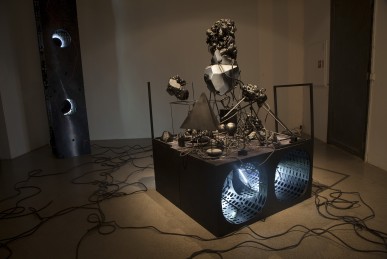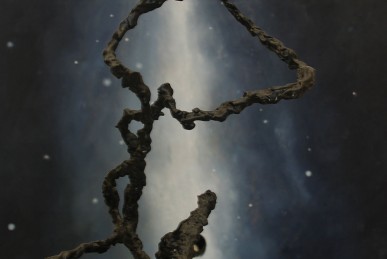



Javier Barrios Structural Complexity
“Nothing is ever absolute, so my work must reflect this same fact,” said Javier Barrios in a conversation. This statement reflects the artist’s continuous search to find a balance between fact and fiction in his work. Whether inspired by utopian fictions or immediate facts, his work explores how technology, science and futuristic visions inform our daily existence and our sense of space. Barrios translates the incidental of everyday experience into structural compositions that present reversed complexities in order to challenge the viewer into observing a different order of reality.
Inspired by an incidental composition of building blocks he encountered while walking down the street, Barrios took a picture of the arrangement and reinterpreted it by inserting various objects and sculptural elements to claim an imaginary, fictional space that is yet expressive of our attempts to organise and dismantle the surroundings. His intervention could be seen as an intrusion into the fabric of reality: a passage from a constructed situation to a performative gesture that sees functional qualities of the ‘original’ arrangement – the rectangular shapes, the symmetrical perforations or its inherent structural logics – being reinterpreted within an expanded field. In doing so, Barrios refuses the literal observation of the fixed elements of place and destabilises their consolidated condition. This is a metaphorical, strictly artistic gesture to practice an imaginary place and reveal how art can question fragmented situations or our conflictual relations to unstable conditions. While the specific qualities Barrios observed in the ‘original’ arrangement refer to a structural balance, their unintended ‘aesthetics’ reveal something about the abstract language of construction and technology. Forms that often go unnoticed have a strong impact on the construction of our immediate reality and come to shape our visions of the future.
In his interpretation of the elements, Barrios makes manifest the structural complexity and vulnerabilities of forms and projected visions by displacing them into an imagined landscape. The material is not converted into sculptural forms as such but rather into abstract concretions that are surprinsingly expressive of our ‘natural’ surroundings. The artist disposes of the immediate social or political references defining the urban environment and explores a field where art is pure and unshaped immanence. This distinct mode of engagement into the real holds the same power to question the idea of the social and the temporality of the ‘original.’ Barrios is engaged in collussion with the real to expose more sophisticated relations and projections as well as a self-reflexive process of creating the artistic object. Often emphasised by the contrasts and oppositions between light and dark, these elements and their fragile relations break down into unmoudled matter, creating tension in relation to the structural formation of the volumes. It expresses both the assembled logics of the conglomerates that make its structure and the dynamic movement towards unknown formations.
The use of light to create different impressions of the compositions and play with the surface of these concretions, in a way that is meant to disrupt analogies and recognition patterns, allows the artist to expose certain areas and shapes of the installation, to create more of the rigorous geometrical shapes. Yet this is only one of the several elements that interact and compete with each other in Barrios’s composition: “I never see my work as individual elements, but rather as a combination of different elements and expressions put together to create a dynamic complexity.” Light allows him to induce subtle reverberations across the plane of concretions and geometries, to illuminate the calm and lucid tension of their equilibrium. Whether one choses to see the material, geometrical, formal and substantial elements of the work as an expression of technologised aesthetics or as an artistically political gesture to dismantle constructions, representations and foundational logics, the fragile and accidental oppose nature by attempting to be just as ‘natural.’ These geometrical natures are “abstracted” from reality; their geometrical perfection and sense of purity is reinterpreted in a series of combinations, rhythms and reorderings that alter their shape not to control the surroundings, but to question the fragile foundations of our environment and, ultimately, of our existence.
It is the artist’s task, as Javier Barrios claims, to strip reality down to its fundamental givens and capture its essence. By taking a fixed and knowable situation that both defines and escapes our ideas of sculpture, architecture, or landscape, the artist operates an expressive displacement. It is a “situational” gesture that Barrios performs when placing what is otherwise a recognisable element into a completely different setting. This serves to address questions of space, context and time, and to reveal our complicit, inherently human relationship with the structural. Such artistic situation – challenging the many theoretisations of site and non-site, place and non-place, public space and landscape, architecture and politics, science and technology – serves as a means to rethink how art can destabilise place; it allows the artist to engage into an accidental situation that creates a sense of interruption and questions the role of artistic agency in specific places. By expanding the frame of the ‘original’ site, Barrios also generates a shift from the critical limits of the site, to transform the gallery space at Trafo Kunsthall into a metaphorical limit of our phenomenological experience. Structural Complexity reveals a mode of interaction with the real engendering a transformative artistic practice. In its rhetorical manoeuvre, the work challenges the meanings and myths attached in the collective imagination to our sense of space and the living. It does so by forcing us to accept the fundamental instability of our places, constructions and projections. This dislocation, however, is not meant to disrupt our sense of the real – on the contrary, it encourages one to grow aware of the relations, mobilities, displacements and contingencies that constitute the very essence of our existence and our relation to nature.
– Sabin Bors, September 17, 2015